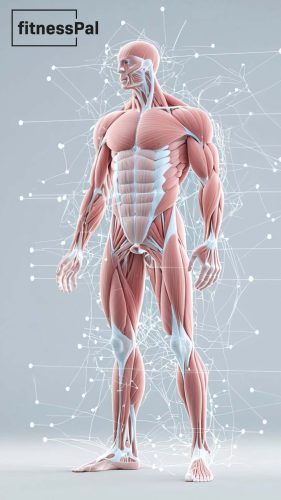Table of contents
Ready to transform your body through muscle gain? You're about to embark on an exciting journey backed by science and proven results. In just three months, you can achieve significant muscle growth with the right approach and realistic expectations.
Let's break down what you can actually expect to gain. If you're new to strength training, you could build 6-12 pounds of muscle in three months, according to research from Business Insider. For those with some experience, expect 3-6 pounds of new muscle. Advanced lifters might see gains of 1.5-3 pounds in the same period.
Your success depends on three key factors: proper nutrition, consistent training, and adequate recovery. Healthline reports that you'll need to eat in a slight calorie surplus while consuming 1.6-2.2 grams of protein per kilogram of body weight daily.
The journey won't always be linear. Some weeks you'll see amazing progress, while others might feel slower. That's completely normal! Studies from Men's Health show that factors like sleep quality, stress levels, and genetics play crucial roles in muscle development.
Remember, this transformation isn't just about lifting weights. It's about creating sustainable habits that will serve you long after these three months. With dedication to proper form, nutrition, and recovery, you're setting yourself up for lasting success in your fitness journey.
Ready to get started? The next sections will guide you through exactly what you need to do, step by step. Let's make these next three months count!
Understanding Muscle Gain Rates
Let's get real about muscle gains - your results will vary based on your fitness journey. Beginners, you're in for an exciting ride! Research shows you can gain 2-4 pounds of muscle monthly in your first year of training. That's up to 12 pounds of new muscle in just three months!
For those with 1-2 years of training under your belt, expect 1-2 pounds of monthly gains. While this might seem modest compared to beginner gains, it's still impressive progress. Advanced lifters, your gains will be more subtle - typically 2-4 pounds across an entire year, according to Business Insider.
Several factors influence your muscle-building potential. Your genetics play a significant role, as highlighted in research from InBody USA. Sleep quality, stress levels, and hormonal balance all impact your results. Even your age matters - younger adults typically build muscle more efficiently than older individuals.
Want to maximize your gains? Focus on consistency rather than quick fixes. A study from Men's Health shows that steady, progressive training yields better long-term results than sporadic intense workouts. Track your progress monthly, but remember - sustainable muscle gain is a marathon, not a sprint.
Remember to adjust your expectations based on your starting point. If you're new to strength training, celebrate those early gains! More experienced? Focus on small improvements in both strength and muscle size. Your transformation journey is unique to you, and every pound of muscle gained is a victory worth celebrating.
Nutrition: The Foundation of Muscle Growth
Building muscle starts in the kitchen. Your body needs the right fuel to transform those tough workouts into impressive gains. Let's break down exactly what you need to eat to maximize your muscle growth.
First, you'll need to eat more calories than you burn. Aim for a surplus of 300-500 calories daily to support muscle growth without excessive fat gain. Track your food intake using a reliable app or food journal to stay consistent.
Protein is your best friend during this journey. Research shows you need 1.6-2.2 grams of protein per kilogram of body weight daily to optimize muscle growth. For a 70kg person, that's about 112-154 grams of protein per day. Space your protein intake across 4-5 meals for better absorption.
According to Healthline, carbohydrates play a crucial role too. They fuel your workouts and help with recovery. Aim for 4-7 grams per kilogram of body weight daily, focusing on complex carbs like sweet potatoes, brown rice, and oats.
Don't forget about healthy fats. The Journal of Sports Sciences recommends getting 20-35% of your calories from fats to support hormone production and muscle growth. Include foods like avocados, nuts, and olive oil in your diet.
Timing matters too. Eat a meal containing protein and carbs 2-3 hours before training. Within 30 minutes after your workout, have another meal with both protein and carbs to kickstart recovery. This approach, supported by Sports Medicine, helps maximize muscle protein synthesis.
Stay hydrated by drinking at least 3-4 liters of water daily. Proper hydration improves workout performance and supports muscle recovery. Consider adding electrolytes during intense training sessions.
Remember, consistency is key. Missing occasional meals won't derail your progress, but aim to hit your nutrition targets 80-90% of the time. Track your progress and adjust your intake based on how your body responds.
Effective Training Strategies
Ready to transform your body? Let's dive into the most effective training approaches for building muscle. Your workout strategy is the blueprint for success in your transformation journey.
Compound exercises are your secret weapon for maximum muscle gain. These powerful movements work multiple muscle groups simultaneously, triggering a stronger growth response. According to Fitbod, exercises like squats, deadlifts, and bench presses should form the foundation of your training program.
Here's your optimal weekly workout structure:
- Train each muscle group 2-3 times per week
- Perform 3-4 sets per exercise
- Aim for 8-12 reps per set
- Rest 48-72 hours between training the same muscle groups
Progressive overload is your key to continuous growth. Start with a weight you can handle for 8-12 reps with proper form. Add weight or reps when you can complete all sets with perfect technique. This steady progression ensures consistent muscle development.
Your muscle-building workout split might look like this:
- Monday: Chest, Shoulders, Triceps
- Tuesday: Back, Biceps
- Wednesday: Rest
- Thursday: Legs, Core
- Friday: Upper Body
- Saturday/Sunday: Rest
Remember to track your workouts. Note your weights, sets, and reps to ensure you're progressing. According to research from Business Insider, consistent progression in your training load directly correlates with muscle growth.
Focus on proper form over heavy weights. Quality movements stimulate more muscle fibers and reduce injury risk. Start each workout with your compound lifts when you're fresh, then move to isolation exercises to target specific muscles.
Stay consistent with your training schedule. Research shows that missing workouts can slow your progress by up to 50%. Schedule your gym sessions like important meetings – they're non-negotiable appointments with your future self.
Recovery and Rest: Your Secret Weapon for Muscle Growth
Want to know the real MVP of muscle building? It's not just about crushing it in the gym - it's what happens when you're not working out that counts. Quality rest is your ticket to stronger, bigger muscles.
Sleep is your body's prime time for muscle repair. Aim for 7-9 hours of solid shut-eye each night. During deep sleep, your body releases growth hormone, which is crucial for muscle recovery and growth. Research shows that poor sleep can reduce muscle protein synthesis by up to 18%, according to Men's Health.
Active recovery days are just as important as training days. Try light activities like walking, swimming, or yoga between workouts. These gentle movements boost blood flow to your muscles without adding extra stress. According to Fitbod, 48-72 hours of rest between training the same muscle groups is ideal for optimal growth.
Your muscles need fuel to recover properly. Within 30 minutes after training, grab a snack with both protein and carbs. This "anabolic window" helps kickstart muscle repair. Studies from Healthline suggest aiming for 20-30 grams of protein during this time.
Watch for signs of overtraining - constant fatigue, decreased performance, or ongoing muscle soreness are red flags. If you notice these symptoms, take an extra rest day or two. Remember, muscles grow during recovery, not during workouts.
Quick recovery tips:
- Use foam rolling to ease muscle tension
- Stay hydrated throughout the day
- Try contrast showers (alternating hot and cold)
- Get regular massages
- Keep stress levels in check
Listen to your body - it's the best guide for knowing when to push and when to rest. Smart recovery isn't being lazy - it's being strategic about your gains.
Gender-Specific Considerations for Muscle Growth
Let's be real - your body's blueprint matters when it comes to building muscle. Both men and women can achieve impressive transformations, but understanding your biological starting point helps set realistic goals.
Men typically pack on muscle faster due to higher testosterone levels - about 2 pounds per month when starting out. Women generally gain around half that amount, usually 1 pound monthly in the beginning. But don't let these numbers discourage you! According to InBody's research, consistent training leads to significant results regardless of gender.
Your workout approach should match your goals, not your gender. Women benefit just as much from heavy lifting as men do. Focus on compound movements like squats, deadlifts, and bench presses - these exercises trigger muscle growth for everyone. Research from Men's Health shows that progressive overload is key for both genders.
Nutrition needs vary too. Women typically require fewer calories than men, but protein remains crucial. Aim for 1.6-2.0 grams of protein per kilogram of body weight daily. A study in Healthline confirms this range supports optimal muscle growth for both genders.
Remember, consistency beats everything else. Track your progress, adjust your program as needed, and celebrate your gains - whether they come fast or slow. Your transformation journey is unique to you, and that's exactly how it should be.
Tracking Progress: Your Roadmap to Measuring Muscle Gains
Getting stronger is exciting, but tracking your progress accurately makes the journey even better! Let's explore the most effective ways to measure your gains and stay motivated during your transformation.
The Power of Progress Photos
Take weekly photos in consistent lighting and poses. Wear similar clothing and snap shots from the front, side, and back. Morning photos work best since your body hasn't been affected by daily activities. These visual records often reveal changes you might miss in the mirror.
According to InBody USA, visual progress tracking helps maintain motivation, with 71% of successful transformations including regular photo documentation.
Measuring Your Success
Track these key metrics weekly:
- Body measurements (chest, waist, arms, legs)
- Body weight first thing in the morning
- Strength gains in your main lifts
- Energy levels during workouts
- Recovery time between sessions
Research from Men's Health shows that tracking multiple metrics provides a more accurate picture of progress than relying on scale weight alone.
Smart Progress Adjustments
Your transformation journey needs regular fine-tuning. If you're not seeing expected results after 2-3 weeks:
- Review your calorie intake
- Check your protein consumption
- Assess workout intensity
- Evaluate sleep quality
- Monitor recovery time
Fitbod reports that successful transformations often require 2-3 program adjustments during a 3-month period.
Remember, progress isn't always linear. Some weeks you'll see dramatic changes, while others might show minimal visible progress. Stay consistent with your tracking, and trust the process!
Common Mistakes to Avoid
Starting your muscle gain journey is exciting, but watch out for these science-backed pitfalls that could slow your progress. Let's break down the most common mistakes and how to avoid them.
Training Mistakes That Stall Progress
Skipping proper form for heavier weights is a major setback. According to a study in the Journal of Strength and Conditioning Research, proper form leads to 23% better muscle activation. Focus on controlled movements and perfect technique before increasing weight.
Program hopping is another progress killer. Research from Men's Health shows that sticking to one program for at least 8-12 weeks is optimal for muscle growth. Resist the urge to switch workouts weekly.
Nutrition Errors That Limit Gains
Not eating enough is surprisingly common. Healthline reports that you need a surplus of 250-500 calories daily for optimal muscle growth. Track your calories to ensure you're eating enough.
Protein timing matters more than you think. Research from InBody shows that spreading protein intake across 4-6 meals optimizes muscle synthesis compared to eating the same amount in 2-3 meals.
Recovery Red Flags
Overtraining isn't just a myth. According to Fitbod, training the same muscle groups without 48 hours of rest can decrease strength gains by up to 25%. Schedule rest days between targeting the same muscles.
Poor sleep sabotages gains. Studies show that getting less than 7 hours of sleep can reduce muscle growth by up to 30%. Prioritize 7-9 hours of quality sleep nightly.
Setting Realistic Expectations
Don't expect dramatic changes overnight. Business Insider reports that beginners can gain 2-4 pounds of muscle monthly, while advanced lifters might only gain 0.5-1 pound. Track progress monthly, not daily.
Remember, sustainable gains take time. Focus on consistent progress rather than rapid results that often lead to burnout or injury.
Conclusion
Your 3-month muscle transformation journey is more than just a fitness goal – it's a commitment to lasting change. Remember, building muscle is a gradual process that requires patience, dedication, and smart planning. The science shows that beginners can gain 6-12 pounds of muscle in three months, while more experienced lifters may see slower but steady progress.
Success comes from combining proper nutrition, consistent training, and adequate rest. Focus on consuming enough protein (1.2-1.6 grams per kilogram of body weight), performing compound exercises, and getting 7-9 hours of quality sleep. According to Men's Health, maintaining a modest caloric surplus of 250-500 calories supports optimal muscle growth without excessive fat gain.
Ready to start your transformation? Begin by calculating your daily protein needs, planning your workout schedule, and setting realistic monthly targets. Track your progress through photos and measurements, but remember – sustainable gains take time. As Fitbod reports, consistency in your approach will lead to better long-term results than rushing for quick fixes.
Your transformation journey starts now. Stay focused on your goals, trust the process, and celebrate every milestone along the way. Remember, every rep brings you closer to your stronger, better self.







